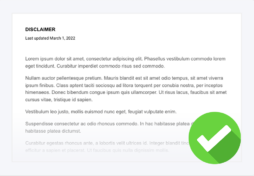A copyright disclaimer is a statement that claims ownership of original content or discloses your use of copyrighted materials for “fair use” purposes.
You need a copyright disclaimer on your website or app if you have branding, materials, videos, images, or other creative works you own and want to express your intellectual property rights over. It can also help prevent your works of parody, commentary, or criticism from getting unfairly copyright-struck.
There are two types of copyright disclaimers we focus on in this article:
- Original work copyright disclaimer: This disclaimer can be used on blogs, websites, images, videos, music, and even social media to establish your ownership over original content. Having this statement helps protect your work against theft.
- Copyright disclaimer under Section 107 of the Copyright Act: This disclaimer appears on content — commonly YouTube videos — that uses someone else’s copyrighted content. Including this statement of “fair use” helps protect you against copyright infringement claims.
Keep reading to learn why copyright disclaimers may be necessary to protect your business, see examples of real copyright disclaimers, and discover how to make one for your website or app.
- What Is a Copyright Disclaimer?
- When Do You Need a Copyright Disclaimer?
- Are Copyright Disclaimers Legally Required?
- Components of a Copyright Disclaimer
- Copyright Disclaimer Under Section 107 of the Copyright Act
- YouTube Copyright Disclaimer
- Facebook Copyright Disclaimer
- Copyright Disclaimer for Music
- Where To Display a Copyright Disclaimer
- Copyright Disclaimer Examples
- Use Copyright Disclaimers Carefully
- Copyright Disclaimer FAQ
- Summary
What Is a Copyright Disclaimer?
A copyright disclaimer is a type of disclaimer that declares your ownership over original content you’ve created and grants you the exclusive rights to display, distribute, copy, and adapt your work.
Copyright protections are a type of intellectual property right which legally protects your creations, inventions, and expressions of ideas.
Technically, your work is protected by copyright as soon as you create it, meaning the laws protect it immediately, even if you never publish a disclaimer. But it’s easier to prove ownership over your work if you post a copyright disclaimer.
Your work is only protected under copyright laws for a specific time before it becomes part of the public domain, and the timeline varies depending on the laws where you live.
Copyright Disclaimers and Fair Use
You can also use a copyright disclaimer to express your “fair use” of other copyrighted materials.
The definition of fair use is very broad and can be interpreted in multiple ways, but it essentially refers to using or copying copyrighted materials for transformative purposes, like:
- Commentary
- Criticism
- Parody
Let’s discuss these terms in a bit more detail.
Commentary and Criticism
Under the basis of fair use, you are legally allowed to replicate parts of copyrighted works to comment or criticize something, like:
- Quoting song lyrics in a music review
- Summarizing medical, scientific, or other research for a paper
- Copying paragraphs from news articles for educational purposes
- Reproducing or copying materials to use as evidence in a court case
Copyright laws allow the reproduction of materials under fair use because it adds value, reliability, and integrity to your critical reviews and commentary.
Posting a fair use disclaimer helps prevent your commentary or criticism from getting copyright-struck unfairly.
Parody
Fair use principles also allow you to mimic, make light of, or satirize otherwise copyrighted works in a comedic way, known as parody.
Parodies often reproduce the feelings of the original work and, by their nature, almost always reference or use parts of it in broader ways than commentary and criticism.
A fair use disclaimer can help prevent your parody from getting an unnecessary copyright strike.
When Do You Need a Copyright Disclaimer?
You need a copyright disclaimer if you want to protect any original content that you’ve created, including but not limited to:
- Apps
- Art
- Blog posts
- Branding
- Choreography
- Designs
- Photographs
- Poems
- Song lyrics
- Videos
- Writings
Are Copyright Disclaimers Legally Required?
Copyright disclaimers are not legally required, and your work is protected by these laws even if you do not post one; however, it’s harder to prove your ownership in court without one if someone ever abuses your materials.
Plus, if you don’t post one, people might mistakenly believe they can reproduce, share, or use your work when that may not actually be the case.
Since a copyright disclaimer is incredibly easy and quick to create, you’re better off posting one just to be safe.
You can also register your copyright, which makes it even easier to sue anyone infringing on your intellectual property rights. However, a simple disclaimer is usually more than enough.
Components of a Copyright Disclaimer
There are four primary components of a copyright disclaimer:
- The copyright symbol
- The year of publication
- The name of the owner
- A statement reserving the rights of the owner
You can choose to include some or all four of the aspects listed above in your copyright disclaimer.
Let’s go over these components in a little more detail.
The Copyright Symbol
Including the copyright symbol or signifier in your disclaimer is required, as it indicates that your work is copyrighted, and it looks like a C with a circle around it: ©
You can also use the word copyright or the abbreviation Copr instead of the © symbol.
Copyright laws vary internationally, so while the symbol is not required in the US, other countries may not recognize your copyright unless the symbol, word, or abbreviation is present.
In the screenshot below, see how hair accessories brand Chunks includes both the word copyright and the © symbol in their disclaimer posted in their website’s footer.
![]()
The Year of Publication
Another required component of your copyright disclaimer is the year you published your content, which can differ from the year you initially created it.
Specific months or days are not relevant for copyright disclaimers. All you need to put is the year you released your content to the public.
In the screenshot example below, notice how the retail store TJ Maxx includes the date 2023 in their copyright disclaimer.
![]()
If you regularly add new content to your website but want to protect older, previously published materials, you can put a date range in your copyright disclaimer to cover all of your intellectual property, like how fast-food chain Mcdonald’s does in the screenshot example below.

By putting the years 2017-2022, Mcdonald’s is establishing their rights over the older and newer content posted on their website.
The Name of the Copyright Owner
Another essential component of your copyright disclaimer is the name of the owner of the work, which can be an individual or your company.
Make sure the owner’s name is clearly identifiable, like in the screenshot below from Amazon, which gives ownership to Amazon.com, Inc. or its affiliates.
![]()
A Statement Reserving Your Right
The final component of your copyright disclaimer is the only optional piece, which is the statement of your rights.
This declares what rights you’re asserting over your content and can be any of the following:
- All rights
- Some rights
- No rights
If you don’t include this component in your copyright disclaimer, it’s automatically assumed that you’re retaining all rights.
Let’s go over these statements in more detail.
All Rights Reserved
If you want to keep all intellectual property rights granted to you under copyright laws, then put the statement ‘All Rights Reserved’ at the end of your copyright disclaimer.
The statement should come after the symbol, the date, and your name.
Look at the screenshot below to see how Walmart reserves all rights over their intellectual property in their copyright disclaimer.
![]()
Remember, if you do not put a statement explaining what rights you reserve at the end of your disclaimer, then it is automatically assumed you’ve reserved all rights.
Some Rights Reserved
If you want to retain some rights over your content but waive other rights, then just put ‘Some Rights Reserved’ at the end of your copyright disclaimer.
It’s common for people to reserve some property rights over things like stock photos and designs that can be redistributed or modified but not sold for profit.
For example, below, you can see a copyright disclaimer from the non-profit Human Rights Data Analysis Group reserving some rights over their content, which they allow to be shared, used, and distributed but not for profit and as long as the group is appropriately credited.
![]()
No Rights Reserved
If you want to waive all intellectual property rights that you’re granted under copyright laws, then put the phrase ‘No Rights Reserved’ at the end of your copyright disclaimer.
However, the more common way to express reserving no rights over your property is to use the Creative Commons signifier CC0.
It’s common for museums or other educational institutions to release their materials to the public domain using Creative Commons and the CC0 signifier because it allows anyone to study, analyze, and use the resources freely.
For example, below, you can see the copyright disclaimer from the Metropolitan Museum of Modern Art (The Met), which uses the OA symbol to represent the art they have that is part of their Open Access initiative.
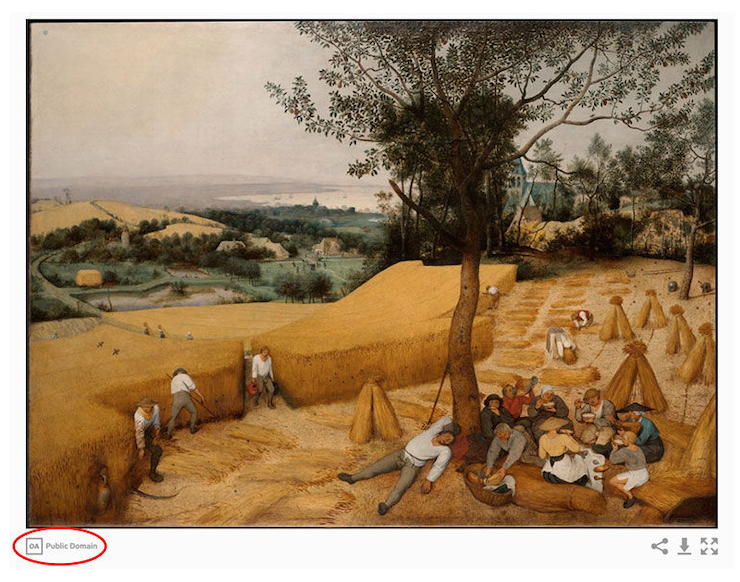
The Met also includes a thorough explanation of their open access policy and goes into further detail about their copyright disclaimer, which you can read below.
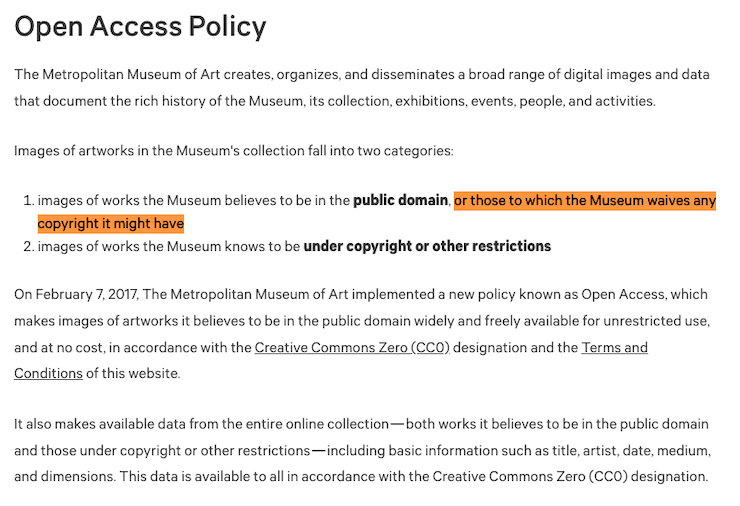
Copyright Disclaimer Under Section 107 of the Copyright Act
While we briefly touched upon this earlier in the article, copyrighted materials can be fairly used for the following purposes, according to Section 107 of the Copyright Act:
- Criticism
- Comment
- Reporting
- Teaching
- Research and scholarship
So if you use copyrighted materials for any of the above purposes, you should post a copyright disclaimer or a fair use disclaimer that states that you’re sampling copyrighted works under the protection of Section 107 of the Copyright Act.
Using this disclaimer can help you combat a copyright infringement complaint. To further protect your use of copyrighted works, you should also credit and link to the original creator.
Here’s an example of copyright disclaimer text you can add to a video or other form of media that uses copyrighted materials in accordance with Section 107 of the Copyright Act:
“This video features materials protected by the Fair Use guidelines of Section 107 of the Copyright Act. All rights reserved to the copyright owners.”
YouTube Copyright Disclaimer
If you post videos on YouTube that use copyrighted content in accordance with fair use principles, you should include a disclaimer in your videos’ descriptions that credits the creator and discloses your fair use rights.
Alternatively, if you’re posting your own copyrighted content on YouTube, you should add a disclaimer of copyright to your videos’ description.
Here’s a standard copyright statement that you can add to your YouTube videos:
“Copyright @ [name & year]. Any illegal reproduction of this content will result in immediate legal action.”
Below, see an example of a copyright disclaimer on the YouTube music video for the Cranberries’ song “Zombie”:

As seen in the example above, your YouTube disclaimer can just be the copyright symbol (or “C” or “Copyright”), but to further protect your intellectual property, we recommend adding an advisement against theft.
If you’re unsure whether your use of copyrighted content is protected, get permission from the copyright owner to use their work or omit the copyrighted content from your video.
Facebook Copyright Disclaimer
Like with YouTube videos, you can only post someone else’s copyrighted content to Facebook if you have the owner’s explicit permission or if the material falls under “fair use” according to Section 107 of the Copyright Act.
Therefore, it’s in your best interest to add a copyright disclaimer to any Facebook post that contains copyrighted material that says:
- the original content
- You have permission to use that content
- A “fair use” allowance protects it
- Disclaims you don’t own
Below is an example of a Facebook copyright disclaimer from Cover Music that says he doesn’t own or make claims to the original music featured in his video:
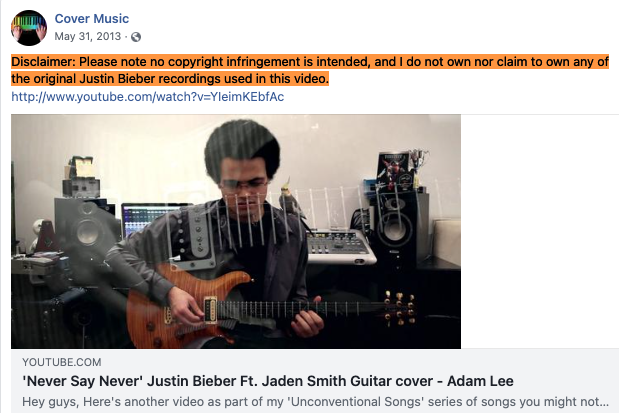
If you post material to Facebook that you’ve copyrighted, such as a video, logo, or music, make sure to add a copyright disclaimer with the copyright symbol, the year of the copyright, and the name of the copyright owner.
Copyright Disclaimer for Music
If you post music online that you own the copyright to, you should add a music copyright disclaimer in its description or as part of the listing.
Music copyrights are unique because sound recording copyright is designated by the phonogram copyright symbol, which is a P with a circle around it: ℗
However, lyrics and composition can still be designated by a standard copyright symbol: ©
If you have music that’s protected by sound recording copyright, standard copyright, or both, add the relevant symbol and copyright date and owner to the music’s listing or description.
Below, see a screenshot example of a copyright notice on SoundCloud:
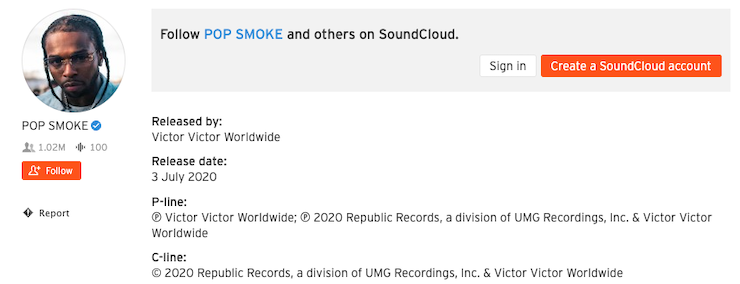
If you’re using someone else’s copyrighted music, make sure it falls under the protection of Section 107 of the Copyright Act or that you’ve been given express permission to use it.
Where To Display a Copyright Disclaimer
You should display your copyright disclaimer in some or all of the following locations:
- Website footer
- Mobile Apps
- Email footer
- Downloadable Materials
Let’s further discuss why each place is ideal for posting your copyright disclaimer.
Website Footer
The most important place to put your copyright disclaimer is in the footer of your website because it is usually static, meaning users can see it no matter where on your site they end up.
Below, see Ebay’s copyright disclaimer that they post in their website’s footer.

Mobile Apps
If you own a mobile app, you should add a copyright disclaimer within the app itself and on any app store listings; this way, consumers can clearly see what rights you’re retaining over your property.
In the screenshot below, see how HBO Max posts a copyright disclaimer on their listing page in the Apple App Store.
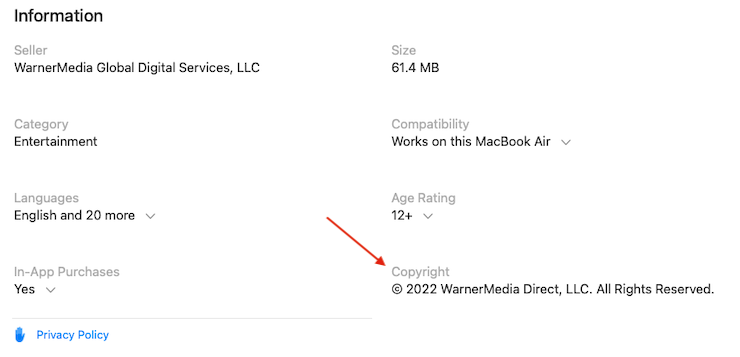
Email Footer
If you send marketing emails to your consumers that contain branding, designs, or other content you want to protect, add a copyright disclaimer to the footer.
For example, the screenshot below shows how Slack includes a copyright disclaimer in their marketing emails.
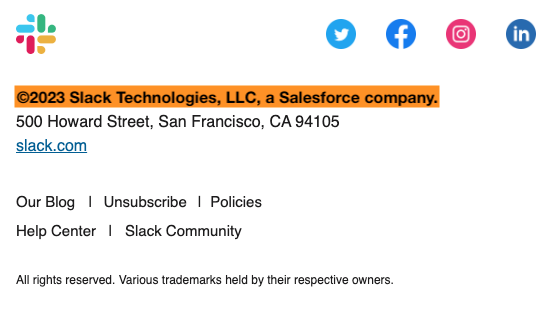
Downloadable Materials
If your website or app offers downloadable content or materials that users can access, put your copyright notice somewhere on the document, either at the very beginning or end, so people know what rights you retain over the content.
Copyright Disclaimer Examples
Let’s look at some real-world examples of copyright disclaimers that appear on the websites of well-known, larger brands.
Apple’s Copyright Disclaimer
Check out the copyright disclaimer that Apple posts on the footer of their website:
![]()
Let’s break this down into the four components we talked about previously in the article:
- Apple uses the word Copyright and the © symbol to mark that it is their copyright disclaimer.
- The year 2023 is clearly marked in their disclaimer.
- They name themselves, Apple Inc., as the owners of the property.
- They clearly state that all rights are reserved.
Target’s Copyright Disclaimer
Next, let’s look at Target’s copyright disclaimer that they post in the footer of their website, pictured below.
![]()
Next, let’s discuss the four components included in their disclaimer:
- Target uses the © symbol to denote that it’s a copyright disclaimer but also includes a TM, which means they’re also trademarking all content and branding.
- The year 2023 is written clearly in their disclaimer.
- Target names themselves, Target Brands, Inc., as the content owner.
- Because Target did not denote what rights they’re reserving, the default assumption is that they reserve all rights over their content.
Use Copyright Disclaimers Carefully
Disclaimers are an important protection measure for anyone operating online, so if you own copyrighted materials, disclose your ownership to help prevent intellectual property theft.
But if you’re using copyrighted material that belongs to someone else, don’t fully rely on a copyright disclaimer to protect you against copyright infringement claims.
While you can use a copyright disclaimer under Section 107 of the Copyright Act to announce your “fair use” of certain materials, your activities must actually be deemed “fair use” for you to avoid infringement claims.
Getting permission to use copyrighted materials from the copyright owner is the safest way to use someone else’s intellectual property.
Copyright Disclaimer FAQ
Take a look at some of the most frequently asked questions we get about copyright disclaimers.
What is the copyright disclaimer under Section 107?
The copyright disclaimer under section 107 states that under certain “fair use” conditions, you can reproduce or use copyrighted materials in otherwise unauthorized ways, specifically for:
- Commentary
- Criticism
- Parody
Is a simple copyright disclaimer enough?
Yes, a simple copyright disclaimer is usually enough to protect your content, and it is a visual reminder to others that you reserve all rights over those materials.
Can you copy and paste a copyright disclaimer?
No, you cannot copy and paste a copyright disclaimer because it will have the wrong ownership name, potentially the wrong date, and the rights reserved may not match the rights you wish to keep.
What happens if others use my copyrighted content without having a disclaimer?
You’re still protected by copyright laws even if you don’t post a disclaimer, but it may be more challenging, time-consuming, and take longer to prove your ownership of your work if you don’t post a copyright disclaimer.
Summary
Copyright disclaimers can protect and maintain your intellectual property rights over the content you own, and they only take a few seconds to make.
The four major components of a copyright disclaimer are:
- The copyright symbol or identifier
- The owner’s name
- The year of publication
- The rights you wish to retain over your content
If you have branding, logos, writing, photos, art, choreography — or other materials your business owns — add a copyright disclaimer to your website or app, so people know what rights you retain over your content.
Copyright disclaimers can also help establish your “fair use” of other people’s work, specifically if you’re reproducing the content for criticism, commentary, or parody purposes.


